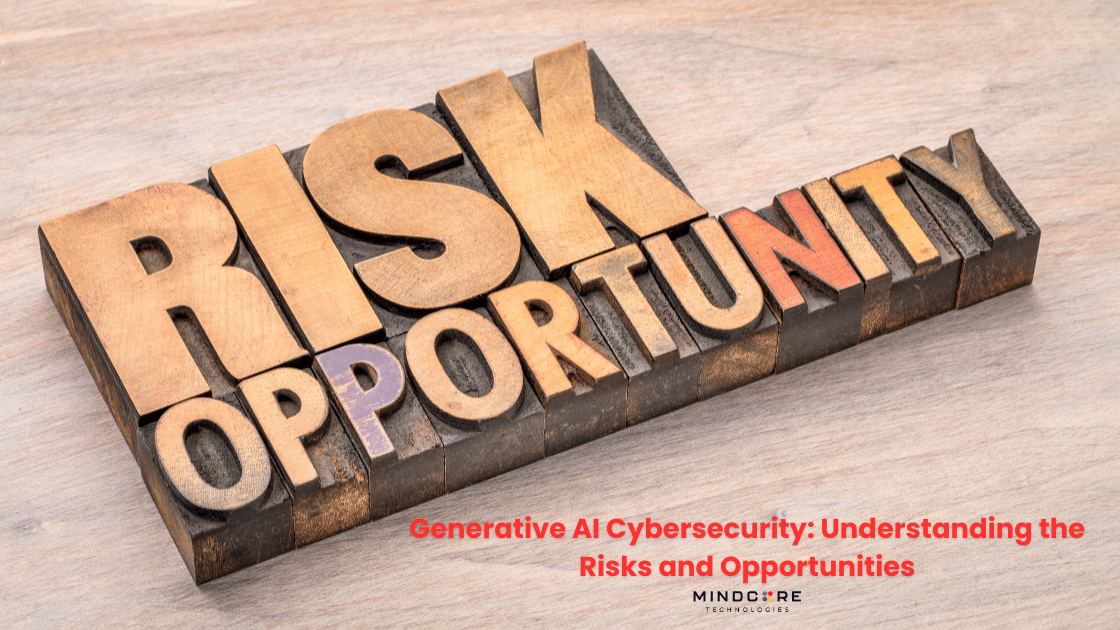| Generative AI Cybersecurity: Key Risks and Opportunities |
Generative AI has been making headlines lately. With the ability to create fairly realistic images or strongly human-like text, it has become a power in the hands of businesses and creators. With great power comes great responsibility: today, generative AI is considered both a threat and an opportunity in cybersecurity.
This blog will explore how generative AI affects cybersecurity, the threats it poses, and how it may be used for the defense.
What Is Generative AI and How Does It Work?
Generative AI refers to artificial intelligence systems that can create content. Output may be anything from text and images to videos and even source codes. Tools like ChatGPT, Midjourney, deepfake software, etc., are popular examples.
Such systems are trained on big sets of data. They learn patterns, styles, and formats so that they can produce new content that looks or sounds authentic in one way or another. While this technology is pretty neat, it also opens new avenues that raise cybersecurity concerns.
Understanding the Risks of Generative AI in Cybersecurity
Generative AI in cybersecurity poses serious threats.
- Phishing threats are becoming more and more threatening. AI is being used to create highly personalized messages to simulate legitimate communications, which are not easy to perpetrate even by the most tech-savvy user.
- A reputation attack is done through deepfakes. With false information smothering brands, fake videos show company executives or public figures.
- Generative AI allows the fastest and quickest production of custom malwares. Pattern-based traditional respected solutions cannot keep pace with such newly created threats.
These risks suggest the need for smart cybersecurity solutions that businesses must seek in the era of AI tradecraft.
Real-Life Examples of Generative AI Cybersecurity Attacks
Generative AI is already being used in cyberattacks. One case involved fraudsters using a deepfake audio call to mimic a company’s CEO. Employees believed they were following legitimate instructions and ended up transferring a huge amount of money.
In another incident, hackers sent AI-generated phishing emails to a global tech company. The emails looked exactly like internal messages, which led to a successful data breach.
These aren’t isolated events. They’re clear signs that generative AI is giving cybercriminals new tools—and reshaping how we think about cybersecurity threats.
Opportunities: How Generative AI Can Strengthen Cybersecurity
Sure, generative AI has its risks. But it’s also giving cybersecurity teams new ways to defend themselves.
Take phishing detection, for example. Tools are being built that can catch sneaky scam emails—stuff that would normally fool people because of how realistic they look.
Some companies even use AI to “attack themselves” on purpose. They simulate hacks to see how well their systems hold up and to train their staff to spot these kinds of threats.
Then there’s automated threat analysis. Going through huge chunks of data manually is slow. But with AI, security teams can get alerts about weird activity almost instantly.
So yes, AI is being used for attacks. But it’s also becoming part of the defense strategy.
Companies Leading Generative AI Cybersecurity Innovations
Several companies stand out when it has to do with generative AI for defense. They focus on providing tools that can detect AI-generated phishing, deepfakes, and other sophisticated threats.
In the case of Darktrace, the business ensures network protection using self-learning AI systems. Conversely, SentinelOne is all about autonomous threat response- using AI to detect and rapidly contain attacks. Furthermore, other players are innovating AI-Cybersecurity tools that blend generative AI with behavioral analytics and thus provide companies with stronger, adaptive defenses.
These industry leaders set the example for generative AI to enhance cybersecurity.
Ethical Considerations of Generative AI in Cybersecurity
Like for any powerful technology, some ethical issues can be raised. The questions about privacy arise when generative AI is used in cybersecurity. Multitudes of monitoring systems will always have to respect any communication data from their users and never overreach their bounds.
On the flip side, quite apart from it being legitimately used, there is always a danger of it being put to much more harsh purposes. Transparency is also necessary on the lines of decision-making of AI systems.
There must be a balance exercised between innovation and responsibility. Ethical AI practices guarantee that defenses work without infringing upon the trust bestowed on them.
Challenges in Implementing Generative AI Cybersecurity Solutions
- The high cost and technical complexity of generative AI technologies present major challenges for organizations looking to incorporate them into their cybersecurity strategy.
- There is a shortage of those who have dual expertise in cybersecurity and AI. Focused training and upskilling would address this issue.
- Regulations regarding the use of AI for cybersecurity purposes are still in development. Therefore, the businesses will want to stay apprised of the developments and be ready to comply whenever they are ready to integrate these technologies.
Owing to all these hurdles, though, there are enormous benefits with using generative AI in cybersecurity: better threat detection and faster response make it a much-needed investment.
Investing in Generative AI Cybersecurity: Market Trends
Investors are taking notice of the growing importance of generative AI in cybersecurity. Companies that are rendering very highly advanced AI-powered defense solutions are now prominent in the stock market.
With cyber threats increasing, the demand for AI-powered protection is increasing. Hence, stocks of generative AI cybersecurity companies would offer a fine option to the investor with a future outlook.
Investors also keep an eye on the top companies providing AI cybersecurity tools and solutions. These businesses are thus positioned for long-term growth with the shifts occurring in the digital threat landscape.
Future Predictions: What’s Next for Generative AI in Cybersecurity?
- Soon, there will be more regulations that guide the generative AI use functions in cybersecurity. Governments and industry bodies are laying down standards, ideally ethical, and effective.
- In the training sphere, a direct focus on generative AI security skills will result in future certifications and training programs while building them ahead of time. These are likely to alleviate the current skills shortage faced by cybersecurity professionals.
- The idea of quantum computing is being fused with AI cybersecurity. Tech firms front-running this innovation will, in all major likelihood, steer the next-gen defense tech.
- With the evolution of cyber threats, generative AI will find itself at the heart of new defense strategies. Hence, keep learning and adapting to protect yourself.
How Professionals Can Prepare for Generative AI in Cybersecurity
For those interested in this field, the first step is to get a solid grasp of the basics of AI. Then, certifications in AI cybersecurity should be sought to build further expertise.
Keeping up-to-date with all that is coming out of generative AI and being aware of their use in actual attacks is essential. Joining professionals’ communities and attending cybersecurity conferences provide further insights.
This can come through labs, which simulate an attack or incidents, helping professionals apply knowledge and keep themselves prepared facing real incidences.
Conclusion
Cybersecurity landscape is reshaped by Generative AI. The flipside of massive attacks and dreadful possibilities are the fortification of digital defense.
Understanding generative AI will keep businesses and professionals ahead of the evolving threats. Development of circumstances through investment in the right tools; generative AI holds promise for ethical design and working practices and continued learning.
As generative AI becomes more integrated into cybersecurity, those who prepare today will lead the way in securing tomorrow’s digital world.

